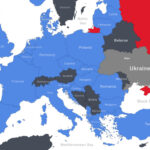Phillip Lagasse and Justin Massie of War On The Rocks report on Canada’s military strength and their readiness to defend. They write:
Canada’s military is in a “death spiral.” This is how Minister of National Defense Bill Blair described the state of Canada’s armed forces at last month’s Ottawa Conference on Security and Defense. Blair’s comments referenced the military’s dire recruitment and retention crisis. The Canadian Armed Forces are short 16,000 people — about 15 percent of their authorized strength of 71,500 regular forces and 30,000 primary reserve forces. Despite efforts such as opening the military to permanent residents, there’s no indication that the situation will improve. Less than 1 percent of applications from permanent residents to join the regular force were accepted, with 15,000 applicants walking away amid the 18- to 24-month-long application process. While the Canadian government has signed several high-profile contracts for new equipment such as F-35s, Predator drones, and P-8A Poseidons, at this rate, there may not be anybody to use these capabilities when they come online.
Allies and critics are rightfully calling on Canada to meet the 2 percent of gross domestic product spending target agreed to by NATO, but the Canadian military’s troubles are deeper than insufficient funds. Canada’s ability to meaningfully contribute to major allied operations is in doubt for the foreseeable future. Despite increased defense spending by 70 percent between 2017 and 2026, an internal report on the readiness of the Canadian Armed Forces was released to the media the same week that Blair made his remarks. The report paints a bleak picture: Most of Canada’s major fleets are unavailable or unserviceable. Indeed, on average, only 45 percent of Canada’s air force fleet is operational, while the Royal Canadian Navy can operate at 46 percent of its capacity and the army at 54 percent. This means that even Canada’s minor military projection ambition — which consists of only three frigates, two fighter jet squadrons, and one mechanized brigade — is not assured. As the ninth largest economy in the world and twelfth largest per capita, Canada actually contributes little to allied security and cannot be relied upon to sustain its own limited ambition. […]
Unless the Canadian Armed Forces solve their personnel crisis, they may not be able to operate the new equipment that is being procured. As pressure on serving personnel increases due to shortfalls within the ranks, more members will be inclined to leave. This is the death spiral the defense minister warned about. While money is not a panacea, spending 2 percent of gross domestic product in defense could help address the shortage of personnel and crumbling infrastructure, as well as acquiring the missing capabilities to sustain operations in the current threat environment. But Canada first needs to solve its structural defense planning issues and, as important, its complacent and self-righteous attitude regarding a military reputation it let slip long ago.
Read more here.
If you’re willing to fight for Main Street America, click here to sign up for my free weekly email.






